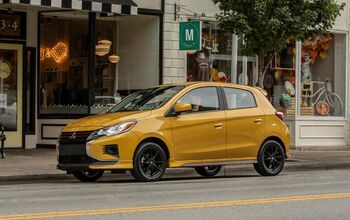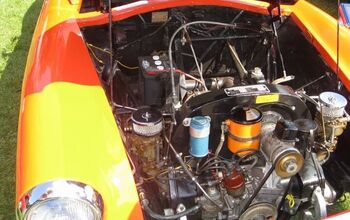Was This Crash Survivable?

If you are active in the auto media, design community, or Ohio’s “foodie” clique, you may know Carl Acampado, the famous Rogue Baker. He’s well-known for his boutique cookies, but he’s also a very competent chef — enough so that I asked him to cater my Wednesday night holiday party.
After preparing a variety of dishes including a splendid steak for yours truly, Carl fired up his mint-condition 1984 Audi Coupe GT to run some cookies to another client. He never came back; if you look at the photo above, you can guess why.
The good news is that he stepped out of the car without a single scratch. To find out how, click the jump.
Carl’s account of the incident:
Last night, around 10:30pm, I was making the last 2 deliveries, on 71 N merging onto 270 E. My car’s rear end swung out unexpectedly, and I collided, at full speed, into the right side barrier wall. Then the car proceeded to bounce off, and finally stopped in the far left high speed lane. For any of you driving on 270 at that time, and wondered what was going on? Sorry. Yes, that was me on a stretcher that was holding up traffic. It’s okay, though. Well, I’m alive, for one. And I all I have to show for it is a bruised rib and thumb…and a totaled car. Sad Panda. The doctors and nurses at St. Ann’s Hospital told me I would feel like an 18-wheeler hit me today. I liken in more to a double decker bus…crashing into us. But like I said, I’m okay, no heavenly dying here. [see what i did there?]
As for deliveries for Saturday, those will have be canceled. I’m sorry for the inconvenience. Regarding future deliveries, let me brainstorm after I stop aching…I’m sure I’ll come up with something. ;)
It’s a common refrain at TTAC that older cars simply aren’t safe enough to drive on public roads… and the definition of “older” varies from “Ford Model A” to “2009 Grand Marquis” to suit the particular rhetorical needs of the poster at the particular time of the post. They often have a point: cars keep getting safer. Still, I think this story shows that a well-engineered car of any vintage can often see out a high-speed crash without killing its driver, or even injuring him much.
If you’re on Twitter, send Carl a word of support… and if you’re in the Midwest, inquire about the “I’m Not A Snickerdoodle!” cookie. You won’t regret it.

More by Jack Baruth
Latest Car Reviews
Read moreLatest Product Reviews
Read moreRecent Comments
- Peter Buying an EV from Toyota is like buying a Bible from Donald Trump. Don’t be surprised if some very important parts are left out.
- Sheila I have a 2016 Kia Sorento that just threw a rod out of the engine case. Filed a claim for new engine and was denied…..due to a loop hole that was included in the Class Action Engine Settlement so Hyundai and Kia would be able to deny a large percentage of cars with prematurely failed engines. It’s called the KSDS Improvement Campaign. Ever hear of such a thing? It’s not even a Recall, although they know these engines are very dangerous. As unknowing consumers load themselves and kids in them everyday. Are their any new Class Action Lawsuits that anyone knows of?
- Alan Well, it will take 30 years to fix Nissan up after the Renault Alliance reduced Nissan to a paltry mess.I think Nissan will eventually improve.
- Alan This will be overpriced for what it offers.I think the "Western" auto manufacturers rip off the consumer with the Thai and Chinese made vehicles.A Chinese made Model 3 in Australia is over $70k AUD(for 1995 $45k USD) which is far more expensive than a similar Chinesium EV of equal or better quality and loaded with goodies.Chinese pickups are $20k to $30k cheaper than Thai built pickups from Ford and the Japanese brands. Who's ripping who off?
- Alan Years ago Jack Baruth held a "competition" for a piece from the B&B on the oddest pickup story (or something like that). I think 5 people were awarded the prizes.I never received mine, something about being in Australia. If TTAC is global how do you offer prizes to those overseas or are we omitted on the sly from competing?In the end I lost significant respect for Baruth.


































Comments
Join the conversation
Of course we're all glad that Carl is here to tell about the story that led to the photo. When you're talking about safety, the question is always "How safe is safe enough?" There are a million answers to that question, which is why the debate is endless. Let's recall that the catalyst for mandated airbags, was the never-ending quest for "passive safety," i.e. somewhat to protect the knucklehead drivers who refused to fasten their seatbelts. When people started walking away from head-ons, in cars equipped with airbags; and those people also reported that they had been wearing their seatbelts, the idea started getting around that the belt-and-bag combination offered some serious protection, and people were impressed. Now seatbelt use is much higher, but no one argues that airbags are unnecessary, as everyone understand that the combination is what really offers the benefit. Regarding older cars, one of the key concepts in body design for crash survivability that has become widespread in the last 25 years, is the concept of the car body "sacrificing itself" to protect the passenger. The 1980s-vintage Mercedes were well built, by the standards of the day; but their crash test performance wasn't that good because the body transferred more of the energy of the impact to the relatively fragile passenger inside. Same with the old Volvos (240-series). Once those engineers internalized the idea that the car body was supposed to sacrifice itself to absorb the energy of the crash (while preserving the integrity of the passenger compartment), then the cars became "safer." After all, it's cheaper and easier to replace or repair the car than the fragile human inside. I remember riding in the bed of a pickup truck going 70 mph down the highway (because there wasn't room for me in the cab) when I worked on a ranch in the early 1960s. But, just because I lived to tell about it, doesn't mean that its safe or I would recommend that anyone do that today. Same thing with the relative safety of cars. Finally, let's be honest, the most important safety component in any car is the driver. People who don't drive impaired, who don't "test the limits" of their vehicle and who are reasonably competent drivers, are very unlikely to have accidents. My father is 85 years old. He's always driven and has never been in an accident. He doesn't drive like a ninny (i.e. under the speed limit or hyper-cautious), but he drives sanely, always pays attention to his driving and never drives impaired. I think he's had about two traffic citations in his life, as well. And, he's probably driven as many miles as the average person of his longevity. We lived in the suburbs, took car vacations, etc.
The front end damage looks pretty minor compared to the head-on at almost 60 mph that I experienced in an '87 Grand Am. I'm surprised the roof buckled in that Audi. Mine buckled much worse, but I think the impact was much greater. They had to use hydraulic equipment to extract me. I was hit by a Chrysler dynasty. http://i754.photobucket.com/albums/xx187/rpn453/Front.jpg http://i754.photobucket.com/albums/xx187/rpn453/PassengerSide.jpg http://i754.photobucket.com/albums/xx187/rpn453/DriverSide.jpg